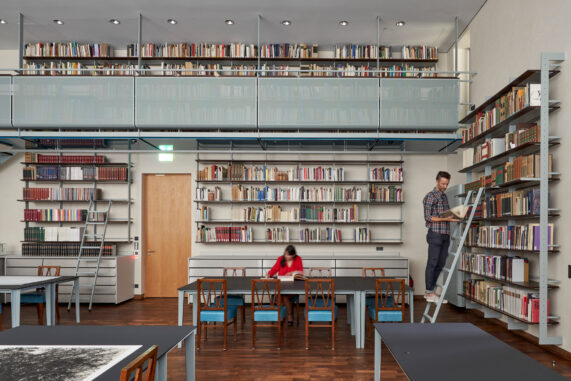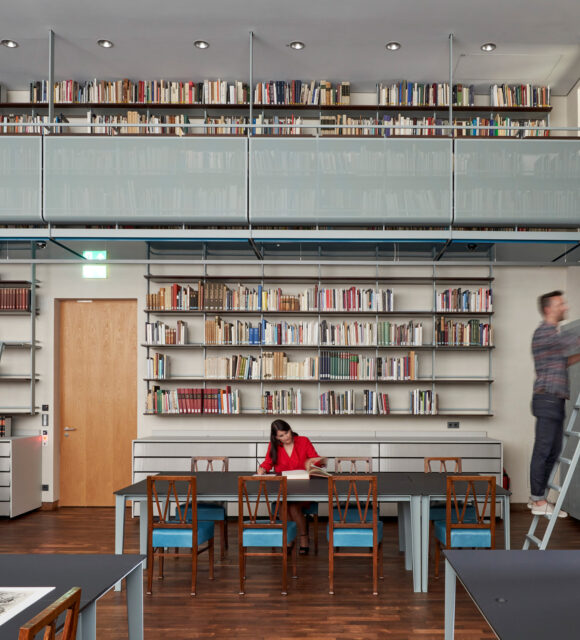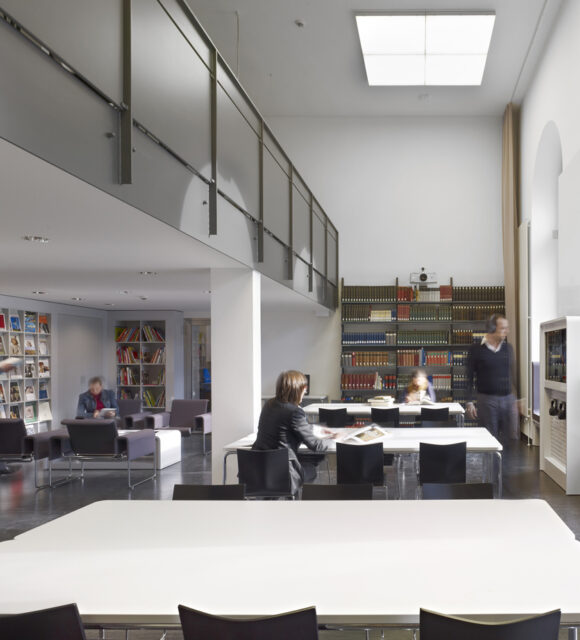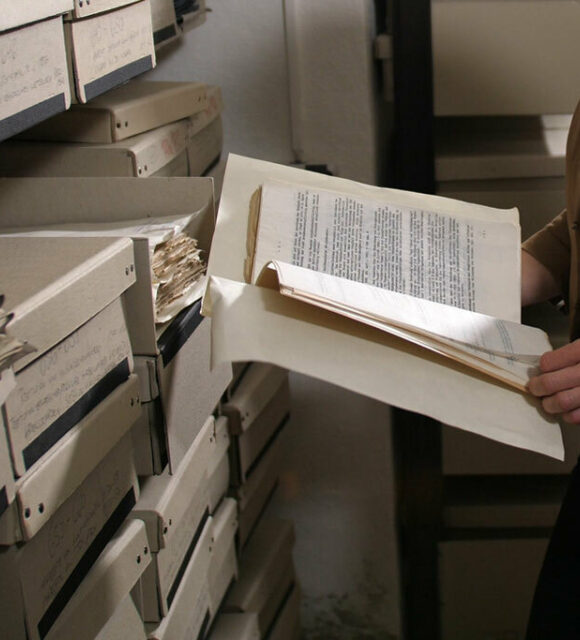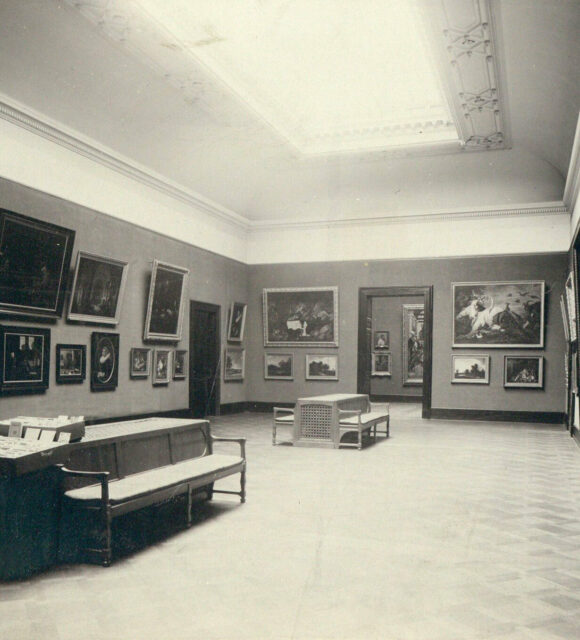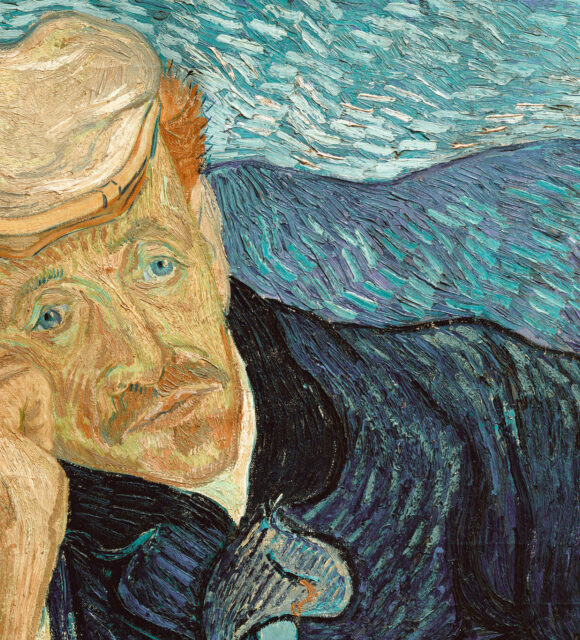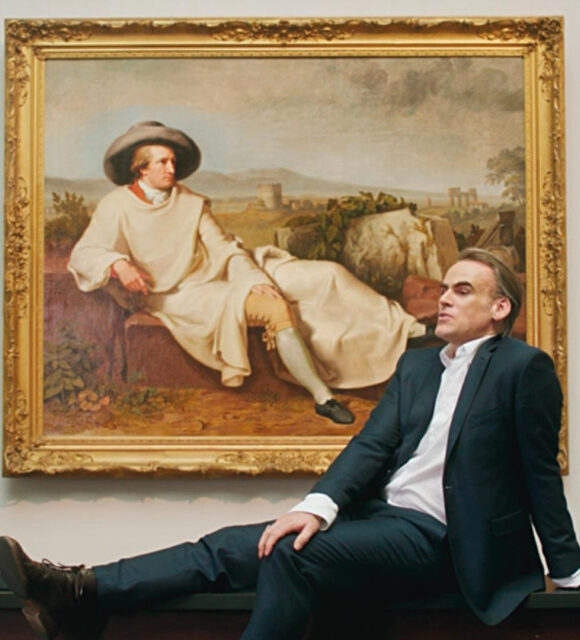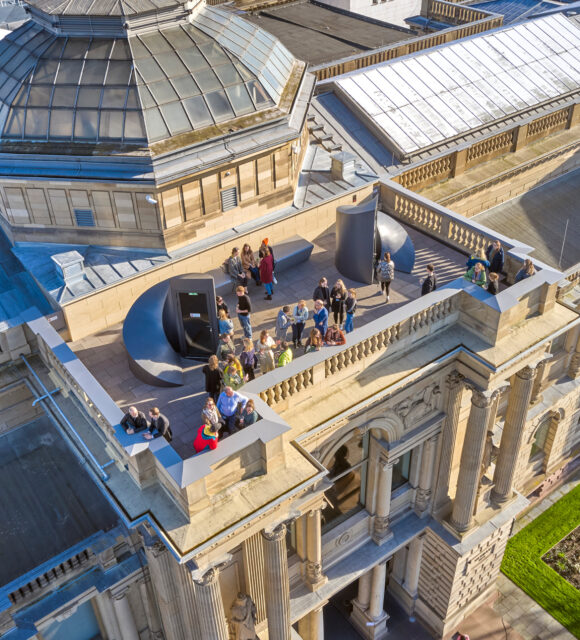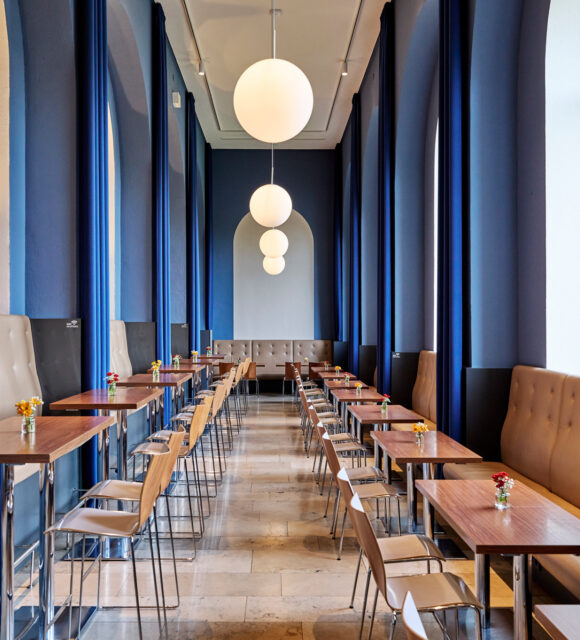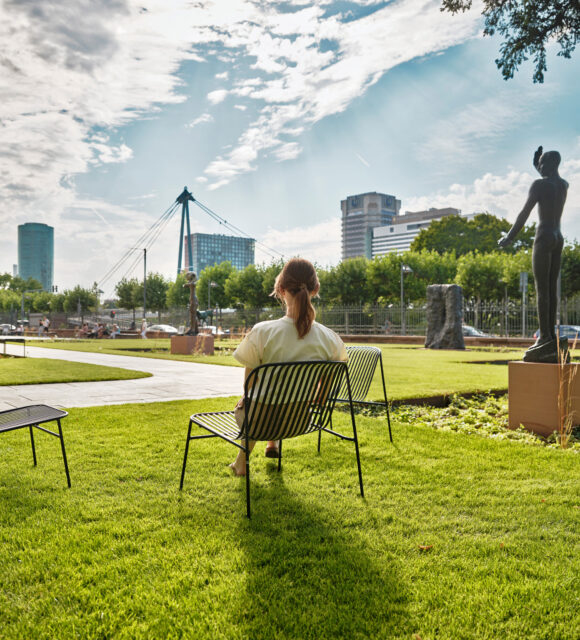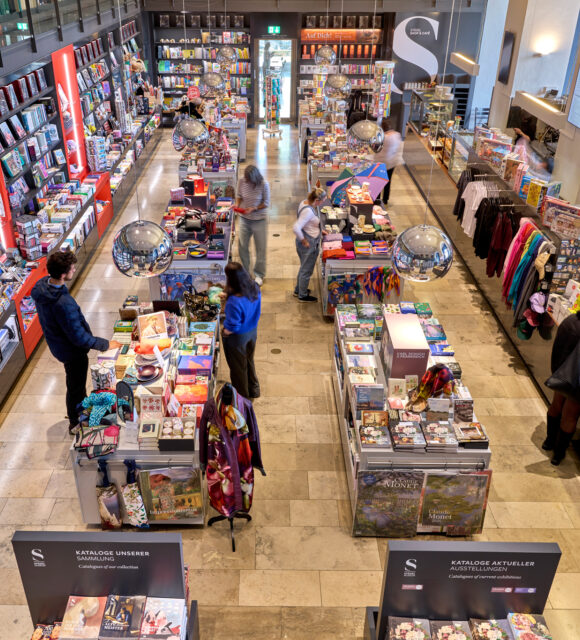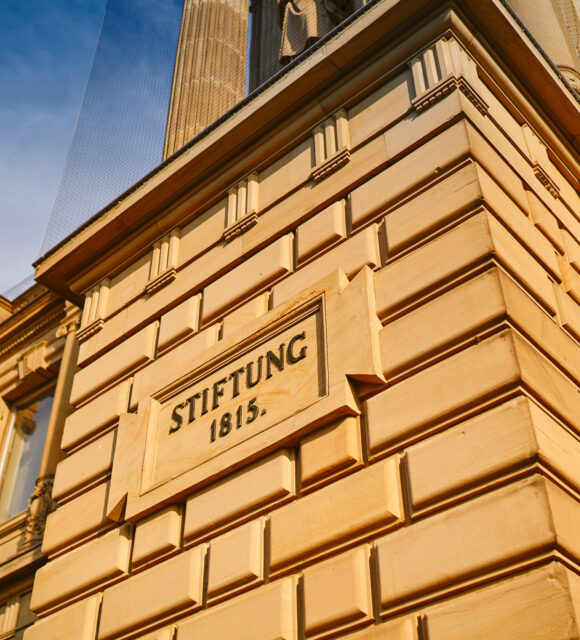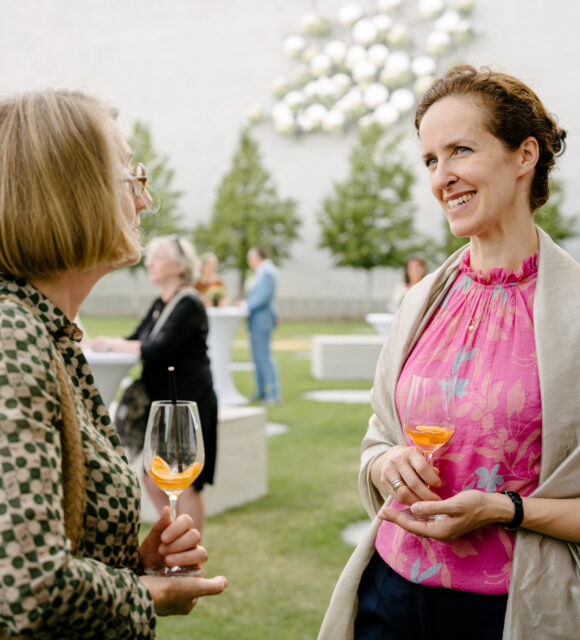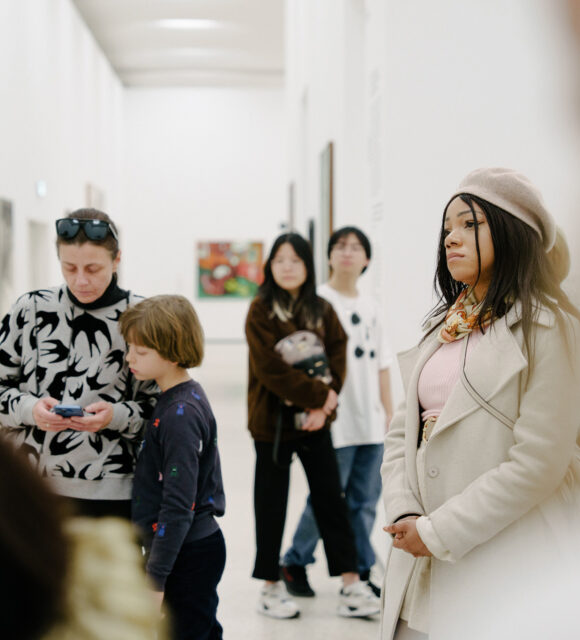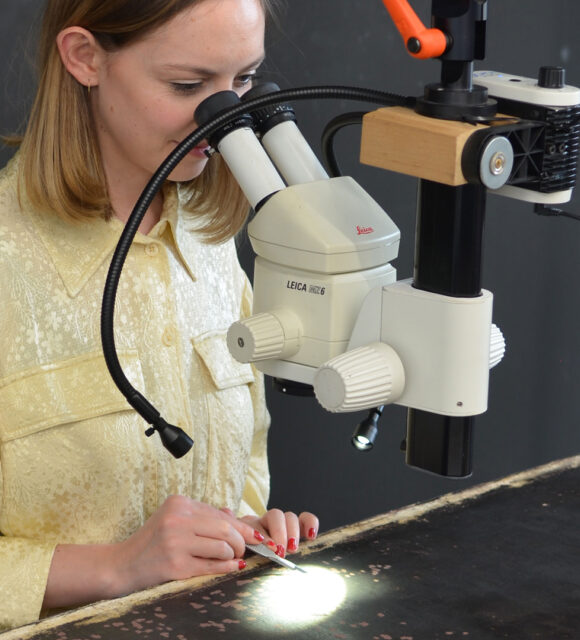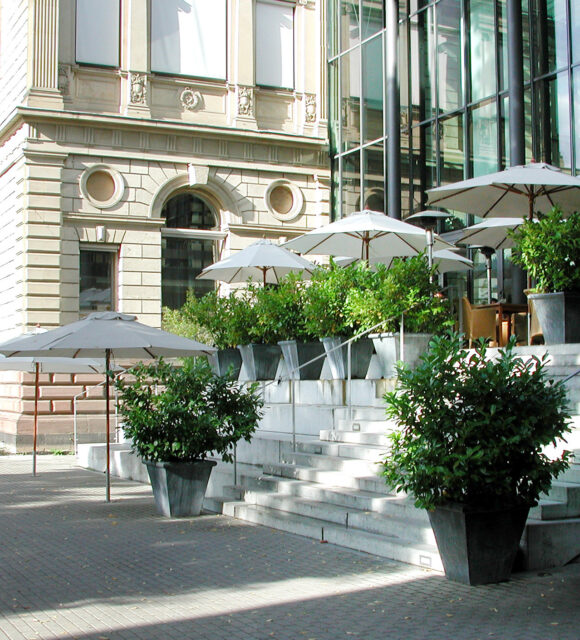Research & Conservation
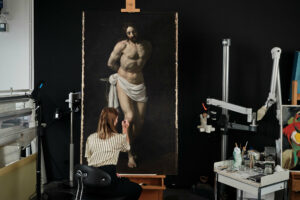
The research and preservation of art is a fundamental part of the museum’s work. Learn more about current research and conservation projects and have a look behind the scenes of our research departments. We offer scholars and visitors various means of carrying out their own studies—on site and online.
Your Research
at the Städel Museum
The Städel Museum’s Department of Prints and Drawings oversees a collection of some 100,000 drawings and prints dating from the Late Middle Ages to the present. Owing to its high quality, it is one of the most distinguished collections of its kind in Germany. View the sensitive holdings close up in the Study Room.
The Städel Museum’s library and mediatheque provide the means of delving deeper into the world of art. The reference library offers audiovisual media, images and extensive literature to all interested visitors.
The historical archive of the Städel Museum brings together more than 150 years of museum and collection history.
Learn more and find out about registration and opening hours. We look forward to your visit.
Digital Collection
Stroll digitally through 700 years of art or search specifically for your favourite work of art.
Current
Research Projects
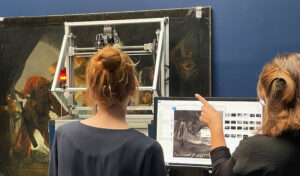
Museological research preserves and broadens knowledge of the cultural legacy that is preserved by museums and forms the scholarly basis for collections and exhibitions.
New Insights into Schuch’s Painting Technique: The Technological Examination of Three Still Lifes
In preparation for the exhibition “Carl Schuch and France” (24 Sept 2025–1 Feb 2026), the Department of Art Technology and Conservation examined three still lifes by the artist, including “Apples on White, with Half Apple” (ca. 1886–1894) from the collection of the Städel Museum. Shapes and structures visible to the naked eye on the surfaces of the three paintings, which did not correspond to the depicted compositions, suggested abandoned and overpainted elements, prompting further investigation.
The works were studied under normal and raking light, ultraviolet radiation, and with a stereomicroscope. Additional insights into the paint layer were provided by infrared reflectography, X-ray imaging, and micro X-ray fluorescence analysis.
This study has shed light on Schuch’s complex working method. Beneath each of the three paintings lies a discarded and overpainted still-life composition. It becomes evident that Schuch reused his canvases multiple times and did not fully plan his compositions in advance but instead developed them throughout the painting process. The findings of this investigation are presented in the exhibition and documented in an essay within the exhibition catalogue.
Contacts
Eva Bader and Linda Schmidt, Art Technology and Conservation - Paintings and Modern Sculptures, Städel Museum

Carl Schuch
Apples on White, with Half Apple, ca. 1886–1894
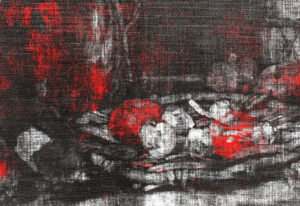
Still Life with Apples, Pears and a Carafe, ca. 1886–1894; Detail of the Abandoned Composition, Distribution of Zinc White and Vermilion in the Micro X-ray Fluorescence Scan
Johann David Passavant and the “Städelsches Kunstinstitut” (1840–1861)
In 1840, the Städelsches Kunstinstitut appointed Johann David Passavant (1787–1861) as its inspector (director). A trained artist from a Frankfurt merchant family, Passavant was among the first ranks of scholarly art experts in Europe. This early generation of art historians gained their profound expertise through in-depth research on original artworks and mutual exchange. Following periods spent in Paris and Rome, research travels across Europe, and numerous art historical publications (including a monograph on Raphael in 1839), Passavant finally secured his long-desired position at the Städel.
Until his death in 1861, he acquired outstanding drawings (such as by Dürer and Raphael) and paintings (including Jan van Eyck’s Lucca Madonna), as well as prints and photographs—demonstrating not only his discerning eye for quality but also his cross-media approach. To this day, Passavant is considered a pioneer in the professionalization of the scholarly art museum.
In 1994, the Städel Museum dedicated an initial exhibition to Passavant, curated by Margret Stuffmann and Hildegard Bauereisen. The current research project builds upon this earlier work as well as on the research of Joachim Jacoby on Johann Friedrich Städel’s drawing collection. At its core is an investigation into Passavant’s vision for the Städelsches Kunstinstitut—examining the thematic priorities he pursued and how he aimed to position the institute on an international level.
To this end, the project is systematically evaluating all administrative reports from Passavant’s tenure, his 37 travel notebooks, and other archival materials, in order to gain deeper insights into the collection and its development.
The research project, which began in January 2025, is funded by the Gabriele Busch-Hauck Foundation and will culminate in an exhibition in 2027.
Project Lead
Dr. Corina Meyer, Department of Prints and Drawings
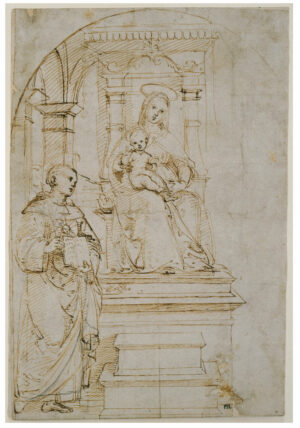
Raphael
Sketch for an enthroned Virgin and Child with Saint Nicholas of Tolentino, ca. 1502–1504
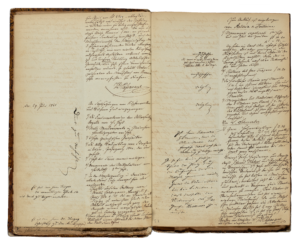
Report by Johann David Passavant to the Board of Trustees, 29 June 1841, from: Reports of Inspector J.D. Passavant to the Board of Trustees (1840-1861)
Provenance research and historical archive
The focus of the Städel’s provenance research activities in 2023 were four works which provenly changed hands in connection with persecution during the Nazi period: the “Portrait of Prof Karl Herxheimer” (1911) by Ottilie W. Roederstein, whose history has been the subject of comprehensive study, and three objects which were returned to the heirs of the former owners. Apart from Fritz von Uhde’s “Portrait of a Lady” (1890), sold to the City of Frankfurt in 1937 by the businessman Gustav Rüdenberg (1868–1941) of Hanover, these works comprise two Baroque angels from the workshop of Meinrad Guggenbichler, originally elements of an altarpiece of around 1704. In the Liebieghaus holdings since 1938, the angel figures once belonged to the physician David Rothschild (1875–1936) of Frankfurt.
In collaboration with the museum education department, a concept for a digital archive was developed for the Städel’s historical archive. In the future, the digital archive will make thematically selected holdings acquired over the course of the museum’s 200+-year history accessible online. The pilot project is the Ottilie W. Roederstein estate in the Roederstein-Jughenn Archive (see digital projects). Selected holdings from this collection are expected to be available digitally from June 2025.
Project lead
Iris Schmeisser
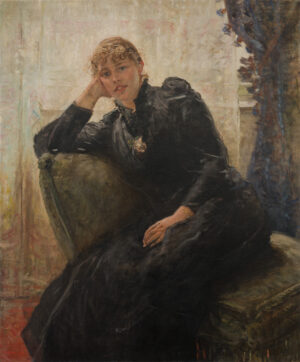
Fritz von Uhde
Portrait of a Lady (Portrait of Therese Karl), 1890
Collection Catalogue of German Paintings in the Städel Museum, 1725-1800
Funded by the Deutsche Forschungsgemeinschaft (DFG; German Research Foundation) from 2023 onwards, this project is devoted to an area of the Städel Museum collection that has yet to undergo thorough examination. Continuing the thread of the predecessor project, it is focussing on paintings carried out in eighteenth-century Germany.
The around 120 works that make up these holdings are distinguished by the heterogeneity and strong regional influence typical of eighteenth-century German painting. The highlights include pieces by Angelica Kauffmann, Jakob Philipp Hackert and the world-famous “Goethe in the Roman Campagna” by Johann Heinrich Wilhelm Tischbein. Small-scale cabinet paintings by the so-called Goethe Painters of Frankfurt, among them examples by Christian Georg Schütz the Elder, Justus Juncker, Johann Georg Trautmann and Johann Conrad Seekatz, account for a large proportion of the collection. Portraits of the von Holzhausens, a patrician family of Frankfurt, and works of the Southern German Rococo make up further substantial sub-sections.
As has been the case with the preparations for the Städel’s other Old Masters scholarly catalogues, the investigation of these paintings closely intertwines the art-historical and technical-scientific perspectives. Methods such as microscopy, infrared reflectography and micro-X-ray fluorescence analysis are being employed to gain insights into the processes by which the works were made. The project will document the history of every painting and discuss it against the background of art- and cultural-historical research questions. Discourses on such matters as the social history of artists, the reception of Dutch art and art market research are particularly relevant in this context. The results will be published in a scholarly collection catalogue.
The project is being carried out under the supervision of Dr Friederike Schütt; the responsibility for the technological examinations of the paintings resides with the certified conservator Lilly Becker.
Project lead
Dr. Friederike Schütt
Art technological research
Dipl.-Rest. Lilly Becker
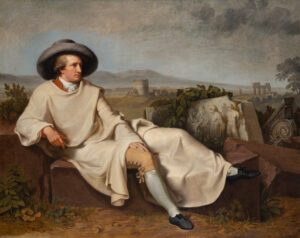
Johann Heinrich Wilhelm Tischbein
Goethe in the Roman Campagna, 1787
Inventory catalogue of Italian Baroque drawings of the seventeenth century
Frankfurt’s Italian Baroque drawing collection goes back in great part to the museum’s founder, Johann Friedrich Städel (1728–1816). Already Städel’s contemporaries admired the drawings in his possession for their quantity and quality alike. None other than Goethe, for example, praised the Guercino drawings after a visit to Städel in October 1815. Launched in 2021 with funding from the Gabriele Busch-Hauck Foundation of Frankfurt, a research project on the Städel Museum’s Italian Baroque drawings was carried out over the past few years. The first step was to take stock of the holdings, which comprise around 500 drawings. Then the focus turned to selecting ninety of the works for further scholarly processing and, in some cases, first-ever scientific examination. The results of this research were presented to the public in 2024 in the exhibition “Fantasy and Passion. Drawing from Carracci to Bernini” and a catalogue with contributions by Stefania Girometti, Sonja Brink, Jutta Keddies and Carel van Tuyll van Serooskerken.
Selected on the basis of quality and function, the works convey an impression of the broad spectrum of techniques and manifold applications of the drawing medium in seventeenth-century Italy. Works by prominent exponents of Baroque art—among them Annibale, Agostino and Ludovico Carracci, Guercino, Gianlorenzo Bernini and Salvator Rosa—were examined along with examples by lesser-known artistic figures such as Giovanni Maria Morandi and Ciro Ferri. The in-depth study of the holdings led to new attributions and iconographic interpretations as well as the clarification of interrelationships between works within the oeuvres of some of the artists. Here the technical analysis of the drawings by the head of the conservation workshop played a key role. The works’ scholarly processing was carried out in close exchange with the project’s mentors, Dr Sonja Brink (Düsseldorf) and Dr Carel van Tuyll van Serooskerken (Amsterdam), the Head of Paper Restauration Jutta Keddies and the Heads of prints and drawings before 1800 Dr Martin Sonnabend and Dr Astrid Reuter as well as numerous international research colleagues. The Gabriele Busch-Hauck Foundation project contributed substantially to the study and exhibition of the Städel Museum’s drawing holdings and the efforts to make them accessible to the public.
Project manager
Dr. Stefania Girometti
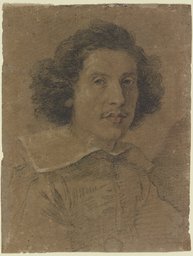
Gian Lorenzo Bernini
Male portrait in three-quarter profile to the right, ca. 1635
Examining artworks with a multispectral camera
Since December 2022, the Städel’s conservation workshop for drawing, prints and photography is using a rather new invention in the field of examining works of art on paper. This filterless, state-of-the-art multispectral camera system (Book2net, Microbox) is capable of capturing images in different wavelengths of the spectral sector without causing damage to the artwork. It thus offers groundbreaking possibilities for examining works on paper.
Works on paper differ from paintings in that their in depth technical examination is still exceptional. In view of the sheer quantity of works on one hand and their fragility on the other, the methods in use to date are often overly time-consuming and above all too invasive and therefore unreasonable strain for the object. Accordingly, numerous research questions have gone unanswered.
The new system enables extremely fast contact-free imaging with simultaneous multiple analysis. Watermarks and paper structures turn visible; signatures, stamps, even artworks concealed under linings on versos become ‘readable’. Preliminary drawings, earlier conservation treatment and ageing processes in the paper come to light. Every conservation measure can therefore build on insights that substantially minimize the risk of misjudgements.
The device can even help in the recognition of forgeries, as drawing mediums react differently in certain wavelength ranges. Zinc white, for example, a material in use only since 1834, cannot be present in a work of the seventeenth century.
At the Städel, the camera will be used above all to analyze works on paper predating 1900. Currently the efforts are being devoted in particular to the Italian Baroque drawings, which are being studied with the help of funding from the Gabriele Busch-Hauck foundation. The results will be published in an inventory catalogue of selected works.
Head of Paper Conservation – Drawing, Print, Photography
Jutta Keddies
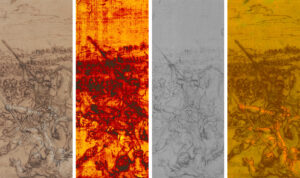
Pietro da Cortona
Alexanderschlacht; Auflicht, Durchlicht (Papierstruktur), NIR 940 (Vorzeichnung), UVF 365 nm (Bleiweißhöhungen, biologischer Befall) (v.l.n.r.)
Current
Conservation Projects
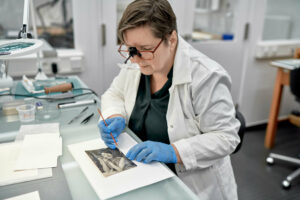
Conservation and restoration make it possible for artworks, even extremely fragile ones, to be presented to the public, and preserves them for future generations.
Master of Flémalle, Robert Campin and workshop, “The Flémalle Panels: Saint Veronica, Virgin and Child”, ca. 1428–1430
Between 2019 and 2025, the paintings “Saint Veronica” and “Virgin and Child” (both ca. 1428–1430), attributed to the Master of Flémalle, underwent comprehensive art-technological research, as well as conservation and restoration work. The aim of this work was to secure the fragile substance in the long term and restore the original effect of the paintings. In the process, important new insights were gained for art-historical research. The restoration work combined state-of-the-art technological methods, such as X-ray imaging, infrared reflectography and micro-X-ray fluorescence, with careful conservation work. This made it possible to stabilize the fragile paint layer and carefully remove yellowed varnish layers, non-original overpainting and earlier retouching. Missing areas were filled in and reconstructed, and the original colouring and detail of the paintings were restored.
The badly damaged brocade background in the work “Saint Veronica” was precisely reconstructed, revealing the use of a technique known as ‘pouncing’, whereby elaborate patterns are transferred to the surface of a painting by rubbing charcoal dust through a template with fine holes. In the painting “Virgin and Child”, the focus was on repairing the extensive damage to the dark blue areas, particularly in the Madonna’s cloak, the original drapery of which was exposed and carefully retouched.
Together with the third Flémalle panel, the “Trinity” (ca. 1428–1430), both works are now on display again in the Old Masters galleries after seven years of intensive research and restoration work.
Restorers
Stephan Knobloch, Head of Art-Technology and Conservation – Paintings and Modern Sculptures (Städel Museum), Linda Schmidt, certified conservator (Städel Museum)
Head of Collection
Prof. Dr. Jochen Sander, Head of German, Dutch and Flemish Paintings before 1800
Supported by
Enthusiasts of the Städelscher Museums-Verein e. V.
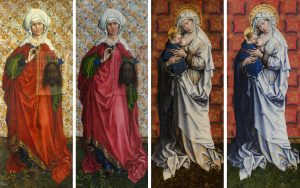
Master of Flémalle
From left to right: Saint Veronica, condition before and after restoration; Virgin and Child, condition before and after restoration
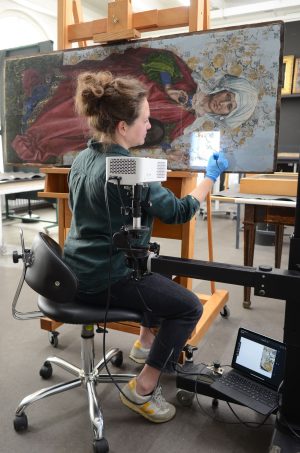
Master of Flémalle
Saint Veronica; reconstruction of the brocade background
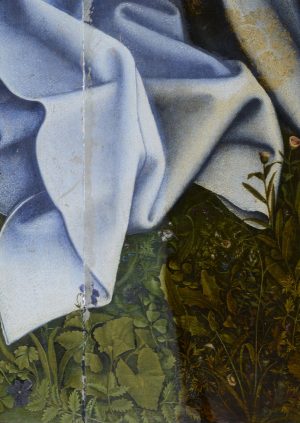
Master of Flémalle
Virgin and Child (detail); condition during removal of varnish and earlier retouching
Rembrandt Harmensz. van Rijn, “The Blinding of Samson”, 1636
The monumental history painting, measuring over two metres in height and more than three metres in width, is one of the central masterpieces of European art history. Previous restorations and natural ageing processes have left their mark on the painting.
The project will begin with a series of comprehensive art technological investigations. These will include X-ray imaging, infrared reflectography, UV and raking light examinations, as well as microscopy and micro-X-ray fluorescence analysis. The aim is to gain a precise understanding of Rembrandt’s original painting technique and subsequent interventions. Based on these findings, the picture support will undergo conservation treatment, non-original materials from previous restorations will be removed, the paint layer will be stabilized, and the appearance will be carefully restored in accordance with Rembrandt’s original artistic intention. Finally, a new frame based on a historical model will provide the work with an appropriate external appearance.
Beyond restoring the aesthetic appeal of the painting, the measures also aim to conserve it for the long term. The knowledge gained in the course of the restoration process will also benefit art-historical and conservation research, as well as future conservation projects. Having been returned to its former glory, the restored painting is expected to be on display again in three to four years.
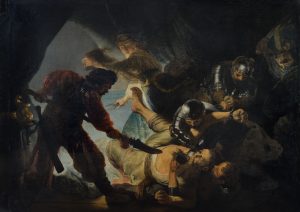
Rembrandt Harmensz. van Rijn
The Blinding of Samson, 1636
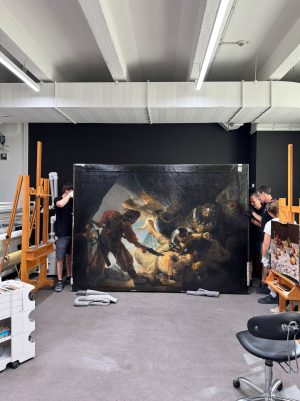
Workshop view
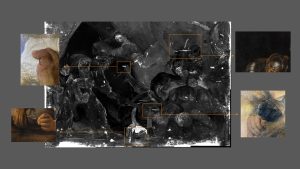
Micro X-ray fluorescence scan (µ-XRF scan)
Pieter Aertsen, “Market Scene with Christ and the Adulteress”, 1559
Pieter Aertsen is regarded as one of the most important painters of the of the genre of market scenes and kitchen interiors in 16th-century Flemish painting. His „Market Scene with Christ and the Adulteress“ (1559), part of the Städel Museum’s collection, is certainly among the most outstanding paintings in the artist’s oeuvre.
The painting has been in the museum’s possession since 1904 and exhibited the typical signs of a chequered restoration history, which had in part significantly altered—indeed distorted—the aesthetic appearance of the work. Moreover, the painting was in urgent need of conservation in order to preserve it for future generations.
For these reasons, the work has been undergoing extensive conservation and restoration since early 2024. This includes the removal of older, non-original varnish layers and discoloured retouchings. The treatment is now in its final phase: the retouching of losses.
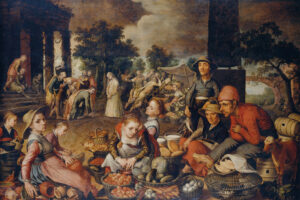
Pieter Aertsen
Market Scene with Christ and the Adulteress, 1559
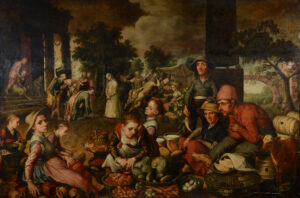
Condition prior to conservation
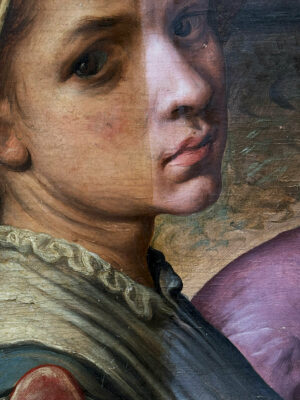
Detail during removal of varnish
Karel Appel, “Portrait of Emmanuel Looten”, 1956
The “Portrait of Emmanuel Looten” is one of the series of “Têtes d’orage” (Storm Heads) executed by Karel Appel in Paris between 1955 and 1956. Appel painted the work on medium-thick natural-fibre fabric he evidently stretched and primed himself. The painting owes its vivaciously dynamic surface structure, which is highly characteristic of this artist’s style, to the wild, pastose paint application with wide brushes and palette knives. The artist added the black paint last simply by pressing it out of the tube onto the canvas.
Certain areas show cleavage between the paint layer and the ground over time. This phenomenon was the worst in the black areas, which had separated from the ground and were lifting. What is more, the surface of the paint layer was so severely soiled as to compromise the work’s aesthetic appearance. The treatment carried out in the Städel Museum’s conservation studio pursued the aim of preventing further loss of material and restoring the work’s original visual impact. Endangered areas of the paint layer were consolidated with an adhesive and the surface was cleaned. Losses were filled and, in a final step, retouched to integrate them into the colour scheme of the surrounding areas.
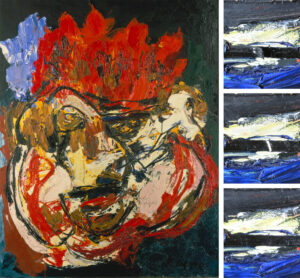
Karel Appel
Portrait of Emmanuel Looten, 1956; general view after completion of conservation (left), detail before conservation (top), detail during conservation (centre), detail after conservation (bottom)
Adolphe Monticelli, “A Painter at Work on a House Wall”, 1875
Measuring just 45.7 × 29.2 cm, the “Painter at Work on a House Wall” is small in scale. Adolphe Monticelli created it by applying extremely pastose paint to a mahogany panel that had previously served as an element of a piece of mahogany furniture. His technique evidently influenced how far more famous artists such as Vincent van Gogh handled oil paint. He applied the paint directly to the unprimed wooden surface and varnished it only in part. A complete coat of varnish was added within the framework of a later conservation measure. That varnish layer was extremely thick, particularly in the most distinctly pastose areas, and had darkened and yellowed to such a degree as to change the work’s colouration substantially.
The recent conservation treatment involved the careful removal of the non-original varnish under a microscope. No new varnish was applied to the surface of the painting. As a result, the overall image is much brighter and the colour scheme much cooler, and fine colour nuances are once again discernible. A decorative frame corresponding to the period of painting’s execution was purchased and now joins the pictorial composition to form a harmonious whole.
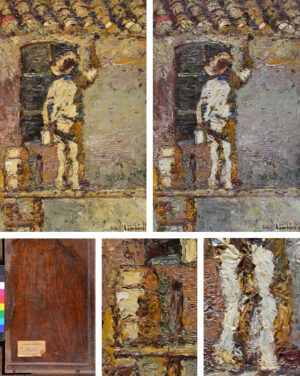
Adolphe Monticelli
Painter at Work on a House Wall, 1875; Before conservation (left), after completion of conservation (right), reverse (bottom left), painter’s legs before (bottom centre) and after varnish removal (bottom right)
Guido Reni, “Christ at the Column”, 1604
The two-year project of examining, conserving and restoring Guido Reni’s painting “Christ at the Column” was completed in 2022. The aim of the project was to improve the work’s aesthetic appearance, which had suffered severely from the consequences of material ageing and multiple earlier restorations. A yellowed layer of varnish, discoloured retouches, and old overpainting, inter alia, obscured the painting. As a result, the characteristic hue and the spatiality of the original work have been lost. The project got underway in 2021 with comprehensive scientific investigations such as micro-XRF scanning, which clarified important questions about the artist´s technique and working process as well as the damages and later interventions on the painting. Its subsequent treatment included the reduction of the varnish, the consolidation of the paint layer as well as the filling and retouching of losses. Due to the measures carried out, the fine color nuances and the interplay of light and shadow have reappeared, as did the sculptural design of the background and the contour lines of detailed areas of the paint layer. After nearly two years, the work recently returned to the exhibition rooms of the Städel Museum and was on view in the exhibition “Guido Reni: The Divine”.
The conservation measures were carried out with generous support from the Bank of America’s “Art Conservation Project”. The purchase of the decorative frame was made possible by contributions from Andreas Dreyer and Waltraud Schwendler as well as Alexandra Junior.
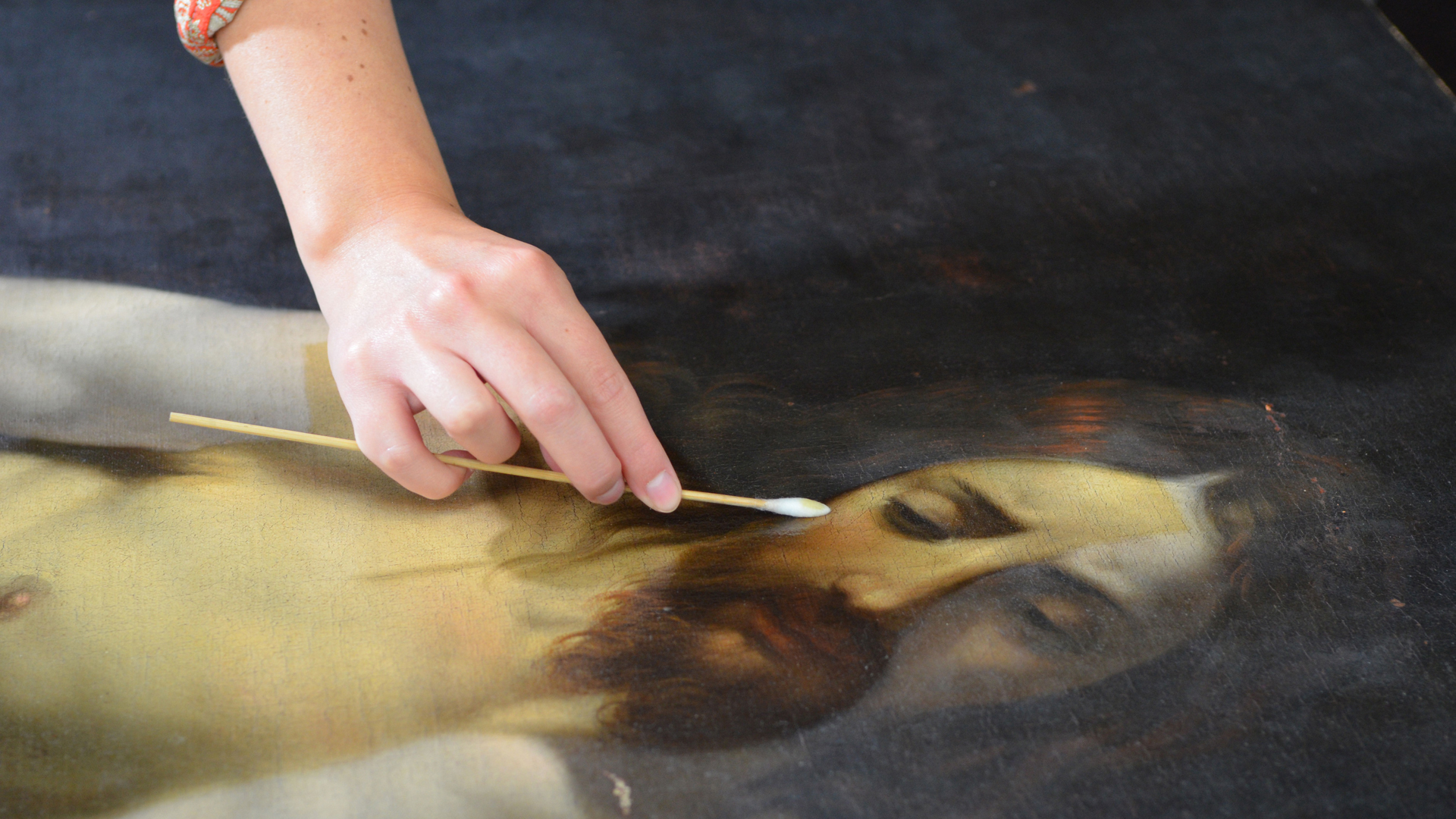
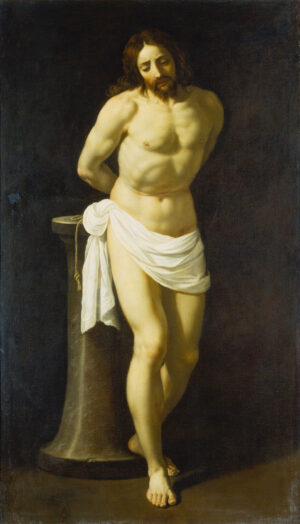
Guido Reni
Christ at the Column, ca. 1604
Conservation at the Städel
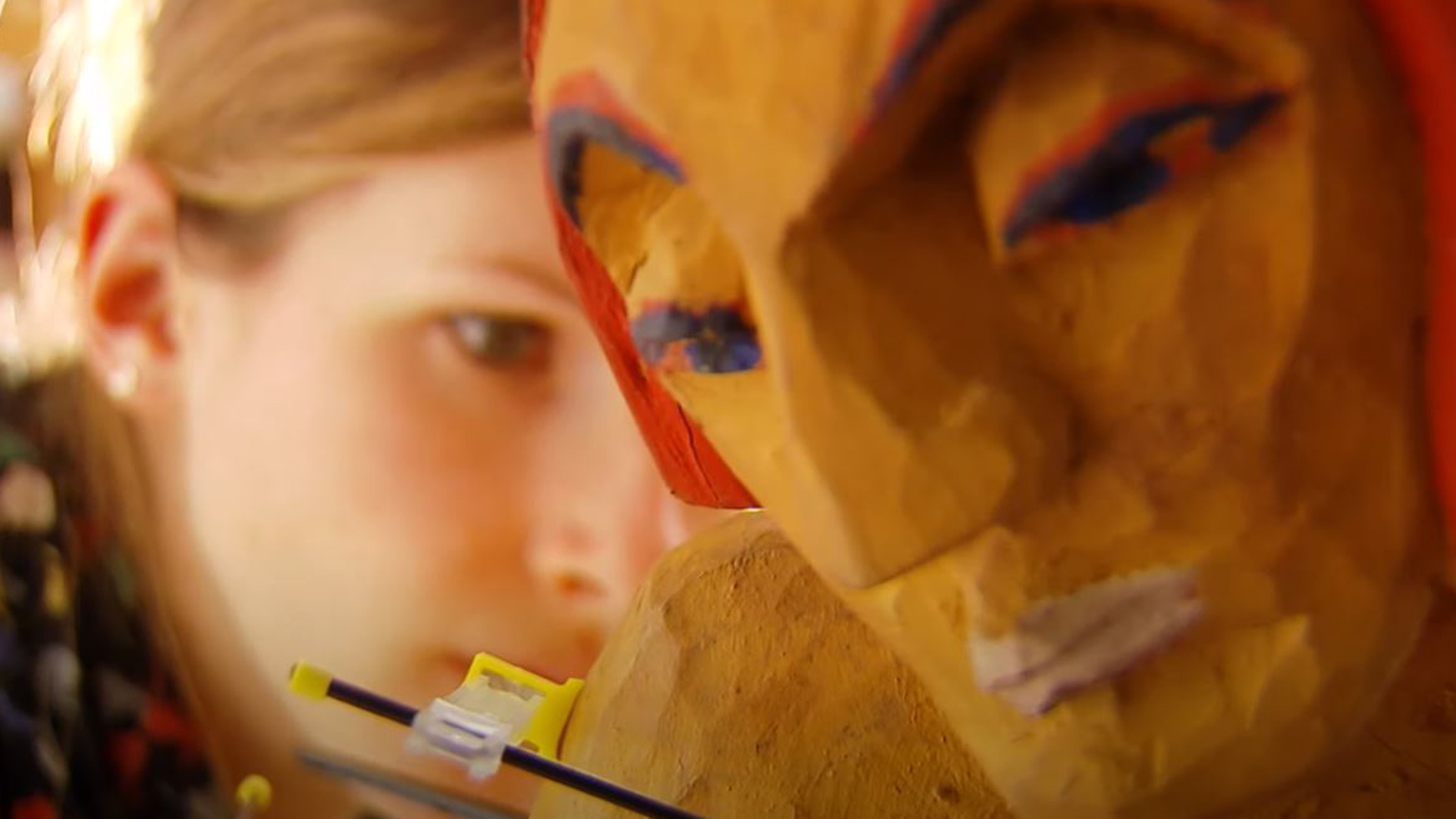
Conservation of Paintings and Modern Sculpture at the Städel Museum
Drawings, prints and photographs
The Städel Museum’s Department of Prints and Drawings has in its holdings more than 100,000 works on paper spanning the period from the fourteenth to the twenty-first century. The drawings, watercolours and pastels number about 25,000, the prints 70,000. The photography collection encompasses more than 5,500 historical and contemporary works.
Preventive measures are necessary to ensure that the fragile works retain as much of their original character and appearance as possible. The harmful effect of light can be minimized by exhibiting the works for a limited time only and in dim light. Damage to the works can also be avoided by controlling the temperature and humidity and employing premium-quality materials, for example for the mounts. It is also to this end that works on paper are always stored in passepartouts or specially produced portfolios.
To ensure the works’ permanent preservation, it is necessary to remove mounts and adhesive backings that have aged or are now known to be harmful, to clean the works and to repair tears that have come about, for example, through storage in portfolios of the wrong size, as well as to address damage caused by long exposure to daylight.
The prints and drawings conservation workshop moreover carries out technical examinations of drawings and prints to determine the medium/s, paper type and working process. These scientific analyses, which are among the methods taught in the framework of academic training and university-level paper conservation studies, are essential for the conservatorial treatment of the works while also providing insights of importance for art-historical research.
Paintings and modern sculptures
The Städel Museum’s Department of Art Technology and the Conservation of Paintings and Modern Sculptures oversees holdings of more than 3,000 paintings and three-dimensional objects spanning the period from the fourteenth century to the present, as well as numerous permanent loans which are integral parts of the museum collection.
One of the museum conservators’ key responsibilities is to develop concepts for preventive conservation. This task includes the optimization of the conditions under which artworks are presented in the museum galleries and kept in the storage facilities. Important factors here, for example, are the control of temperature and humidity as well as protection from light. What is more, globalization and global warming have led worldwide to the migration of vermin, a circumstance posing an increasing problem in many museums. The Städel Museum and its conservation workshops have responded by drawing up an Integrated Pest Management (IPM) plan including strategies for combatting so-called silverfish.
The conservators are also on the scene when a painting or sculpture is lent out to a partner museum somewhere in the world. They examine and document the work, prepare it for transport and often accompany the journey “from nail to nail”. The conditions of works the Städel receives from other museums as loans for its special exhibitions are documented with equal precision.
If one of the collection heads suggests purchasing a particular work for the collection, that work is likewise examined with a view to its condition and authenticity—if possible, in the conservation studio. If the respective work cannot be sent to the museum for inspection, the Städel conservators often travel to its location to carry out an initial analysis there.
Selection of Current
Acquisitions
The Städel Museum collects, preserves, researches and educates about works from over 700 years of art. The museum’s holdings are continuously expanded and developed through selective acquisitions and donations. Our annual report provides an overview of the individual new acquisitions per year.
Contact
Curatorial Team

